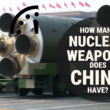Enforcing a ban, preventing treaty capture
By Héctor Guerra, July 9, 2014
In these early years of the 21st century, the international system seems increasingly unstable. Relations between Moscow and Washington exhibit renewed tensions. The Middle East seems to be developing into one big conflict zone. Some areas of the world, including my own region, Latin America and the Caribbean, are experiencing widespread violence outside the context of conventional armed conflict, partly due to transnational organized crime and the prevalence of small arms and light weapons. Meanwhile, global income inequality stands at very high levels. In a world such as this, it simply isn’t safe to maintain arsenals of nuclear weapons.
Over the last several decades, the movement against nuclear weapons has registered some successes—but has also suffered some failures. The Nuclear Non-Proliferation Treaty has checked the spread of weapons technology (even if North Korea joined the nuclear club in recent years) but has not achieved as much in disarmament. Hopes for establishing a nuclear-weapon-free zone in the Middle East are slipping away. The Conference on Disarmament has done virtually nothing since the 1990s. All in all, existing disarmament mechanisms have not lived up to the principles expressed in the UN Charter—for example, the responsibility to prevent war and to uphold fundamental human rights.
A promising way forward is "the humanitarian initiative," a new disarmament effort centered around a series of conferences on the humanitarian impact of nuclear weapons. (Norway hosted the first conference, in 2013; Mexico the second, in February; and Austria will host a third in December.) The initiative seeks to place two facts front and center: that the mere existence of nuclear weapons threatens the security of nations and peoples the world over, and that no country is prepared to respond to the humanitarian crisis that a nuclear detonation would create (even if the detonation occurred in a limited, regional conflict). The initiative also attempts to cut through the clutter that surrounds nuclear disarmament—all the talk about reducing stockpiles gradually, or addressing shortcomings in existing treaties, or gaining assurances from nuclear-armed countries that they will not be the first to use nuclear weapons. The humanitarian initiative generates well-founded hope that a treaty will be established that bans nuclear weapons outright.
The initiative incorporates actors, approaches, and ideas from earlier, and largely successful, efforts to eliminate antipersonnel land mines and cluster munitions—two classes of weapons that unnecessarily take lives and cost people their livelihoods. The 1997 Mine Ban Treaty and the 2008 Convention on Cluster Munitions may not have achieved universal membership yet—the United States, Russia, and China, among other countries, remain outside these instruments—but antipersonnel landmines have been stigmatized and the same is increasingly true of cluster munitions. International trade for these weapons has virtually collapsed, and a virtual prohibition on their use is in place. These arms eradication efforts built on earlier work in nuclear arms control, which curbed proliferation, banned nuclear weapons from several regions, and stopped nuclear tests almost entirely. Now, however, the mainstream nuclear disarmament movement has lost momentum, so the humanitarian initiative is attempting to reinvigorate the process—taking as immediate precedents the Ottawa and Oslo processes regarding antipersonnel land mines and cluster munitions. In terms of foreign policy principles, practice, and accumulated experience, the various disarmament processes are closely intertwined.
Many states have thrown their support behind the humanitarian initiative, as have numerous intergovernmental agencies and civil society organizations. But will the initiative actually lead to a formal diplomatic process? Will it culminate in a treaty that stretches disarmament past its current limits—a treaty perhaps that bans nuclear weapons outright? These are tricky questions.
Nations’ positions on banning nuclear weapons will not be unrelated to their wider foreign policy principles and priorities. Hence, not all states seeking a legally binding instrument banning nuclear weapons will have the same margin for maneuver. Honduras, for example, is part of the nuclear-weapon-free zone for Latin America and the Caribbean. It subscribes to the declaration on disarmament issued in 2013 by the Community of Latin American and Caribbean States. It is participating in the humanitarian initiative. But it is also a country that the UN Development Programme ranks 120th out of 186 countries in its human development index. Honduras’s largest trading partner, meanwhile, is the United States, a nation that holds "an estimated 4,650 nuclear warheads available for delivery by more than 800 ballistic missiles and aircraft." How will Honduras’s economic reliance on the United States influence its behavior in a diplomatic process to ban nuclear weapons?
The humanitarian initiative will succeed only if the countries that support it present a united front. This means that nations in the initiative’s vanguard should establish themselves as a core group of "champions," as it were. The group should include representatives from a variety of regions, but at the same time the group must remain compact enough to allow for like-mindedness in strategy formulation. Such a group would allow the establishment of regional positions on a ban treaty—with the idea that, as one region after another threw its support behind prohibition, pressure would mount on nuclear-armed nations to participate in a treaty process. (The Non-Aligned Movement, which contains a majority of the member states of the United Nations, could play a key role in this.)
The process will not be isolated from other activities in disarmament and international security, or from foreign policy in general, so progress will not be simple or linear. This means that patience and a historical perspective will be indispensable. But when the moment is ripe, the humanitarian initiative can evolve into a major debate within established political forums—hopefully leading to a formal diplomatic process toward establishing a ban treaty.
In any event, before such a process is even begun, enforcement mechanisms must be analyzed and debated. Mechanisms must include common, measurable standards regarding what prohibition and disarmament entail; structures for international cooperation and assistance; a timetable and a budget; and a supervisory body endowed with appropriate powers. A strong institutional foundation is required if banned weapons are to be eliminated—and prevented from reemerging in decades to come.
If such mechanisms are not properly addressed before a diplomatic process is launched, nuclear-armed nations might "capture" any treaty that results. If nations come to the negotiating table bearing only generalities and promises, some states will inevitably block progress toward a strong, meaningful, and long-lasting international treaty, or water down any instrument that emerges. An amorphous debate will only favor the guardians of the status quo. It will only produce a token treaty.
From East and South Asia to the Eastern Mediterranean and the Black Sea, existing geopolitical tensions could escalate at any time into large-scale armed conflict involving nuclear-armed nations. Under such circumstances, can human beings afford not to establish a solid, enforceable treaty that bans nuclear weapons outright?
Topics: Nuclear Weapons
Share: [addthis tool="addthis_inline_share_toolbox"]














